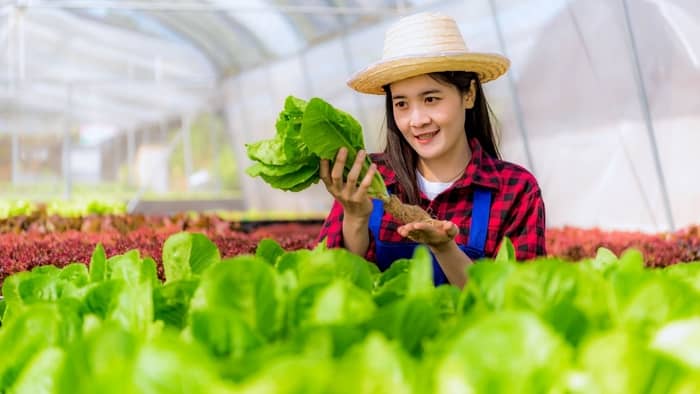Last Updated on September 3, 2021 by Marco C.
Conversations on aquaponics vs traditional farming revolve on the benefit of recirculating water and fish waste making aquaponics a solution for food security. People harvest fish and vegetables in a recirculating environment wherein the plants benefit from fish waste and fish benefit from clean water. This leads to the assumption that aquaponics is extremely efficient in water and nutrient utilization. This statement leads a lot of practitioners to believe in aquaponics as a solution for food security around the world. Aquaponics comes with its own set of inefficiencies and challenges. Although there are advantages to aquaponics, it should be treated simply as an agricultural practice. As with any agricultural practice, we must identify the reason for setting up a farm or small-scale system. This begs the question:
Why Aquaponics?
Aquaponics as a trend in agriculture led many growers to swear by the practice of aquaponics. Individuals attracted by the environmental and organic movements support aquaponics as a sustainable way to grow your own vegetables. Most practitioners promoting aquaponics tend to exaggerate the benefits and ease of setting up your own aquaponics. However, these claims do not necessarily reflect a full understanding of the scientific processes involved in agriculture or aquaponics. That said, it is best to understand the actual benefits of aquaponics based on scientific evidence and reasoning.
Harvesting Both Fish and Vegetables From A Recirculating System
The apparent difference between aquaponics vs traditional farming is the use of aquaculture as a nutrient source for hydroponics. Obviously, this allows aquaponics systems to harvest both fish and vegetables from a single system. Although it is possible to harvest both, commercial operations that harvest both fish and vegetables experience fish kills often. The harvesting of fish lowers the nutrient input in the system. As the fish grow back to market size will lead to an increase in nutrients again. This fluctuation of nitrogen causes stress for the fish in the system and thus leads to fish kills. Fluctuation of nitrogen occurs less in low fish stocking densities or smaller backyard systems. Harvesting both fish and vegetables in a commercial aquaponics system leads to higher risks of loss from fish kills.
Hydroponics and Aquaponics Practices Can be Used Even With The Absence Of Soil
Aquaponics utilizes hydroponic techniques to grow plants without the use of soil. This allows growers to use aquaponics in areas with no soil or poor soil conditions. Not having soil also prevents the exposure to soil-borne pests and diseases.
Learn more about: Aquaponics Grow Bed Calculator
Aquaponics Recirculates Water and Nutrients Limiting The Losses To Runoff
Aquaponics systems have specific inputs and losses making it a semi-closed loop system. Compared to traditional farming where excess water and nutrients runoff into the soil and environment, aquaponics easily limits losses. Although aquaponics does not come without inefficiencies. Some of the overlooked losses for aquaponics often include:
- Evapotranspiration of plants take out water from the system
- Evaporation of water is increased due to the aeration and exposure to atmosphere
- Volatilization of ammonium in water into ammonia gas leads to a minute loss of nitrogen in your system
- Natural denitrification also causes a small loss of nitrates into nitrogen gas into the atmosphere
Aquaponics saves water by recirculating the used water around the system. Although water is recycled, having inputs and losses make it not a closed ecosystem. Rather, aquaponics should be treated as a semi-closed ecosystem.
Comparing Aquaponics Vs Traditional Farming
Both aquaponics vs traditional farming technologies developed over the years, improving efficiencies and practices to reduce waste and optimize growth of crops. Traditional farming has advances as well in precision agriculture that have similar or even better results than aquaponics. Aquaponics does not replace traditional farming, just like how traditional farming does not replace aquaponics. Both practices are viable economically and sustainably if done correctly.
Aquaponics Operations Vs Traditional Farming Operations
Having operated and designed both aquaponics and traditional farms, I observed aquaponics requires more labor and management than traditional farming. Aquaponics operations apply both aquaculture and hydroponic practices. This makes the process very labor-intensive. Operations for aquaponics would include:
- Feeding for the aquaculture unit
- Draining and cleaning of mechanical filter
- Harvesting or Transplanting
- Supplementing of nutrients
- Topping off of water
- Checking of pipes and aeration
- Monitoring of fish health and size
A regular day of operation for traditional farming includes:
- Watering
- Checking for Pests
- Transplanting or Harvesting
- Fertilizing
- Soil Conditioning
Both aquaponics and traditional farming have automation technologies which make operations easier. However, since aquaponics combines aquaculture and hydroponics, operating aquaponics systems become more complex.
Plants That Grow In Aquaponics, Hydroponics, and Traditional Farming Use The Same Nutrients
Nutrients come in a specific form before they become available for use by plants. The form for plant uptake is similar whether in an aquaponics, hydroponics, or traditional farming setup. A complete list of nutrients required and the forms can be found from different sources online. Texas A&M’s AgriLife Extension has a simplified table of all the nutrients and their ionic forms available online.
Aquaponics Systems Have Water-Borne Pests and Diseases While Traditional Farming Has Soil-Borne Pests and Diseases
Aquaponics systems can harbor diseases from aquaculture and hydroponic systems. These include diseases that affect fishes, root rot, or bacterial leaf spot. A large number of pests lay their eggs in the soil, making it hard to get rid of them in traditional farming settings. In aquaponics, these pests do not have soil to lay eggs in. This reduces the number of pests found in aquaponics and hydroponics systems. Elevating the grow beds also makes it harder for these pests to reach the vegetables, preventing some pests from damaging the plants. Aquaponics and hydroponics systems have high humidity making them susceptible to bacterial leaf spot and bacterial root rot. Proper aeration and ventilation of the area reduces bacterial diseases for plants and fishes as well.
Efficiency For Both Aquaponics and Traditional Farming Can Be Met With The Right Practices
Technologies like drip irrigation save water for soil farming. According to MIT news, drip irrigation potentially saves 60% of water consumption. Paired with precision agriculture, simple drip irrigation increases the efficiency of traditional farming by a huge margin. Aquaponics can be considered an agriculture technology.
Aquaponics Can Be Used To Educate The Younger Generation On Physics, Chemistry, Biology, and Engineering Principles
Personally, I find the best way to use aquaponics is for education in universities and schools. Aquaponics systems showcase different scientific principles applied in food production systems. Students can interact with the system and study the physics, chemistry, biology, and engineering behind aquaponics. Components like bell siphons and airlifts show how fluid mechanics can recirculate water using the venturi effect or slug flow. While the nutrients in the water show the importance of water chemistry and plant biology in food production.
No matter what kind of farming technique is used, plants will require the same nutrients and water needed to grow. Aquaponics vs conventional farming just deliver the required nutrients and water differently. Additionally, new technologies and standards are being developed in aquaponics, hydroponics, and conventional farming that increase efficiency of agriculture. A successful farming operation depends on choosing the most suitable practice to the resource and conditions of the farm.

Candace is an aquaponics expert with over 5 years of experience in the field. She has a degree in environmental science from the University of California, Berkeley and a degree in aquaponics from the University of Florida. She is passionate about sustainable agriculture and has a deep knowledge of aquaculture and hydroponics. She has worked on numerous projects and has been involved in the development of aquaponic systems and fish farms. She also has experience in designing and constructing aquaponic systems. With her expertise, Candace is able to advise clients on the most effective and efficient way to construct and manage their aquaponic system. She is an active member of the aquaponic community, often speaking at conferences and seminars. Candace is dedicated to helping others understand the importance of aquaponics, and she is a strong advocate for sustainable food production.



